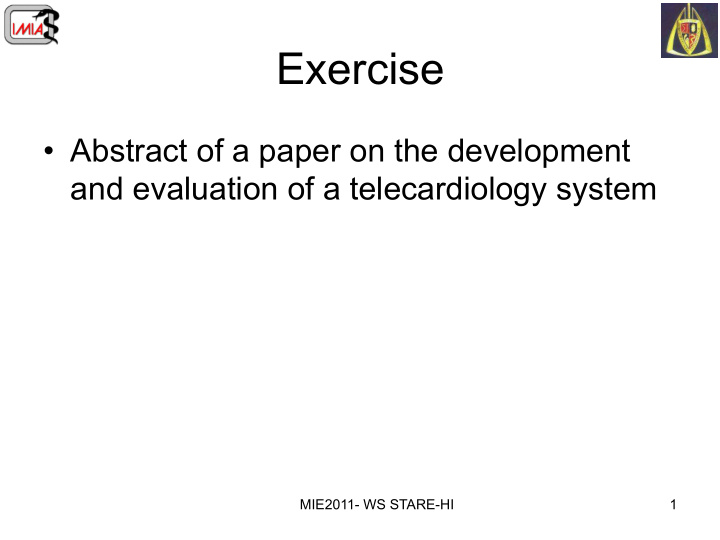



Exercise • Abstract of a paper on the development and evaluation of a telecardiology system MIE2011- WS STARE-HI 1
Question • If you are performing a literature review on the effects of telecardiology in resource- limited settings would you select this article? • Why or why not? • Suppose this would be a ‘ full evaluation paper ’ what should be changed? MIE2011- WS STARE-HI 2
Telecardiology through ubiquitous Internet services • Purpose: The implementation of telemedicine in many clinical scenarios improves the quality of care and patient safety. However, its use is hindered by operational, infrastructural and financial limitations. This paper describes the design and deployment of a plug-and-play telemedicine platform for cardiologic applications. • Methods: The novelty of this work is that, instead of complex middleware, it uses a common electronic mailbox and its protocols to support the core of the telemedicine information system and associated data procedures (ECG and medical images). A security model was also developed to ensure data privacy and confidentiality. • Results: The solution was validated in several real environments, in terms of performance, robustness, scalability and work efficiency. During the past two years it has been used on a daily basis by several small and medium-sized laboratories. • Conclusions: The advantage of using an Internet service in opposition to a server-based infrastructure is that it does not require IT resources to setup the telemedicine centre. A doctor can configure and operate the centre with the same simplicity as any other Internet browser application. The solution is currently in use to support remote diagnosis and reports of ECG and Echocardiography in Portugal and Angola. • Keywords: Telemedicine; Telecardiology; ECG; Echocardiography. MIE2011- WS STARE-HI 3
Title • Term evaluation, validation or assessment X – Evaluation of……. • Type of system • Study question: X – Evaluation of the effect of telecardiology through ubiquitous internet services on workefficiency • Study design: X – Post-implementation evaluation of the effect of telecardiology through ubiquitous internet services on workefficiency MIE2011- WS STARE-HI 4
Abstract • Structured • Objective X – This paper describes the design, deployment and evaluation of the robustness of a telecardiology application – To describe the design and deployment of a telecardiology application and its effect on work efficiency MIE2011- WS STARE-HI 5
Abstract • Methods- the setting – Store and forward or Real time communication? – Commercial or in-house developed software – Inpatient and/or outpatient? – What kind of hospitals (tertiary, teaching, non- teaching)? – How long is the system in use? • Methods- the participants – How many departments/hospitals? – What kind of care givers? GPs and/or cardiologists – How many care givers? MIE2011- WS STARE-HI 6
Abstract • Methods- study design – How are participants selected? Volunteer bias? – Laboratory or field study? – Experimental study or case study? Intervention and control group? • Methods- data collection /analyses – Prospective/retrospective – Statistical techniques for quantitative data – Analysis methods for qualitative data MIE2011- WS STARE-HI 7
Abstract • Define outcome measures X – Performance / Robustness • technical- downtime of system? • Medical- validity of telediagnoses? – Work efficiency • Time spent by junior/ senior cardiologist, • time series of number of patients seen per day? • Waiting time for patient? • Major results X – Report results of outcome measure • e.g hours down, agreement (kappa) of live vs telediagnoses, time spent in minutes (before and after the deployment of the system • Numbers, percentages • No interpretation MIE2011- WS STARE-HI 8
Abstract • Study limitations X – Any bias? Volunteer, hawthorn, checklist? – Unexpected events? • Conclusion X – Answer to the study question: is it a robust system? Does it improve work efficiency? • Keywords – Type of system: telecardiology – Evaluation, assessment X – Outcome measure X X – Study design X – Setting – MeSH terms MIE2011- WS STARE-HI 9
Recommend
More recommend